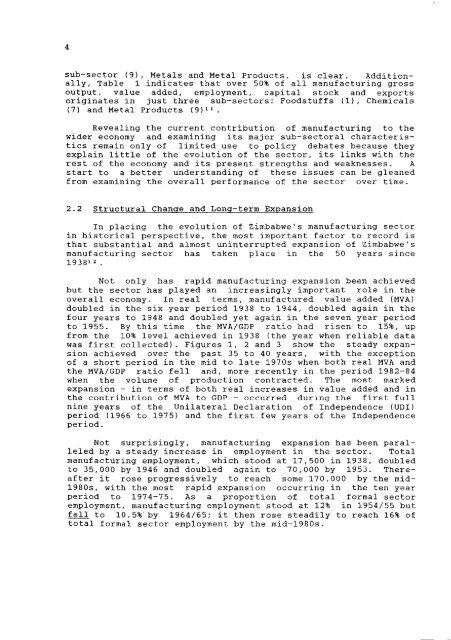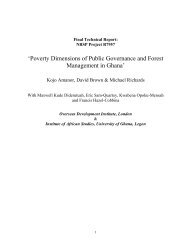Zimbabwe - Overseas Development Institute
Zimbabwe - Overseas Development Institute
Zimbabwe - Overseas Development Institute
Create successful ePaper yourself
Turn your PDF publications into a flip-book with our unique Google optimized e-Paper software.
sub-sector (9), Metals and Metal Products, i s c l e a r . A d d i t i o n <br />
a l l y , Table 1 i n d i c a t e s that over 50% of a l l manufacturing gross<br />
output, value added, employment, c a p i t a l stock and exports<br />
o r i g i n a t e s i n j u s t three sub-sectors: Foodstuffs (1), Chemicals<br />
(7) and Metal Products { 9 ) 1 ' .<br />
Revealing the current c o n t r i b u t i o n of manufacturing to the<br />
wider economy and examining i t s major sub-sectoral c h a r a c t e r i s <br />
t i c s remain only of l i m i t e d use to p o l i c y debates because they<br />
e x p l a i n l i t t l e of the e v o l u t i o n of the sector, i t s l i n k s with the<br />
r e s t of the economy and i t s present strengths and weaknesses. A<br />
s t a r t to a b e t t e r understanding of these issues can be gleaned<br />
from examining the o v e r a l l performance of the sector over time.<br />
2.2 S t r u c t u r a l Change and Long-term Expansion<br />
In p l a c i n g the e v o l u t i o n of <strong>Zimbabwe</strong>'s manufacturing sector<br />
i n h i s t o r i c a l perspective, the most important f a c t o r to record i s<br />
that s u b s t a n t i a l and almost uninterrupted expansion of <strong>Zimbabwe</strong>'s<br />
manufacturing sector has taken place i n the 50 years since<br />
1 9 3 8 1 2 .<br />
Not only has r a p i d manufacturing expansion been achieved<br />
but the sector has played an i n c r e a s i n g l y important r o l e i n the<br />
o v e r a l l economy. In r e a l terms, manufactured value added (MVA)<br />
doubled i n the s i x year period 1938 to 1944, doubled again i n the<br />
four years to 1948 and doubled yet again i n the seven year period<br />
to 1955. By t h i s time the MVA/GDP r a t i o had r i s e n to 15%, up<br />
from the 10% l e v e l achieved i n 1938 (the year when r e l i a b l e data<br />
was f i r s t c o l l e c t e d ) . Figures 1, 2 and 3 show the steady expansion<br />
achieved over the past 35 to 40 years, with the exception<br />
of a short period i n the mid to l a t e 1970s when both r e a l MVA and<br />
the MVA/GDP r a t i o f e l l and, more r e c e n t l y i n the period 1982-84<br />
when the volume of production contracted. The most marked<br />
expansion - i n terms of both r e a l increases i n value added and i n<br />
the c o n t r i b u t i o n of MVA to GDP - occurred during the f i r s t f u l l<br />
nine years of the U n i l a t e r a l D e c l a r a t i o n of Independence (UDI)<br />
period (1966 to 1975) and the f i r s t few years of the Independence<br />
period.<br />
Not s u r p r i s i n g l y , manufacturing expansion has been p a r a l <br />
l e l e d by a steady increase i n employment i n the sector. T o t a l<br />
manufacturing employment, which stood at 17,500 i n 1938, doubled<br />
to 35,000 by 1946 and doubled again to 70,000 by 1953. Therea<br />
f t e r i t rose p r o g r e s s i v e l y to reach some 170,000 by the mid-<br />
1980s, with the most r a p i d expansion o c c u r r i n g i n the ten year<br />
period to 1974-75. As a proportion of t o t a l formal sector<br />
employment, manufacturing employment stood at 12% i n 1954/55 but<br />
f e l l to 10.5%'by 1964/65; i t then rose s t e a d i l y to reach 16% of<br />
t o t a l formal sector employment by the mid-1980s.
















